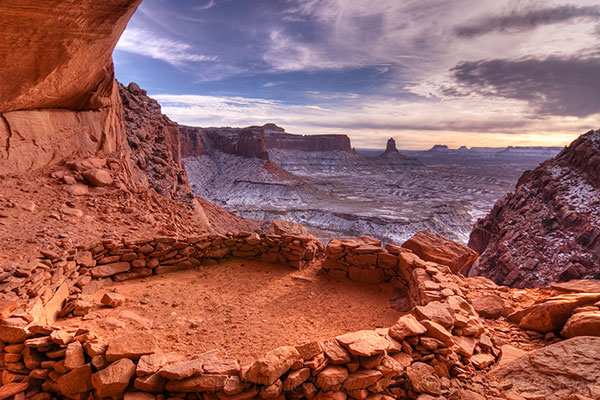False Kiva on:
[Wikipedia]
[Google]
[Amazon]

 The False Kiva is a human-made
The False Kiva is a human-made

 The False Kiva is a human-made
The False Kiva is a human-made stone circle
A stone circle is a ring of standing stones. Most are found in Northwestern Europe – especially in Britain, Ireland, and Brittany – and typically date from the Late Neolithic and Early Bronze Age, with most being built from 3000 BC. The be ...
of unknown origin in a cave in a remote area of Canyonlands National Park, which is located in U.S. state
In the United States, a state is a constituent political entity, of which there are 50. Bound together in a political union, each state holds governmental jurisdiction over a separate and defined geographic territory where it shares its sove ...
of Utah
Utah ( , ) is a state in the Mountain West subregion of the Western United States. Utah is a landlocked U.S. state bordered to its east by Colorado, to its northeast by Wyoming, to its north by Idaho, to its south by Arizona, and to it ...
. It was closed by Canyonlands National Park rangers in early August 2018, as a result of vandalism.
It requires some hiking knowledge or special directions to find.
It has become a popular spot for photographers capturing the Southwest
The points of the compass are a set of horizontal, radially arrayed compass directions (or azimuths) used in navigation and cartography. A compass rose is primarily composed of four cardinal directions—north, east, south, and west—each sepa ...
, offering a unique frame for the dramatic thunderstorms or clear skies beyond.
Origin
While located in a naturally occurring alcove, the name ''False Kiva'' arises from the uncertainty about the circle of stones' origins and purpose, whether it is really an authentickiva
A kiva is a space used by Puebloans for rites and political meetings, many of them associated with the kachina belief system. Among the modern Hopi and most other Pueblo peoples, "kiva" means a large room that is circular and underground ...
, a location used for religious purposes.
Disclosure controversy
Debate rages on whether to disclose the exact location of False Kiva as it enjoys a semi-protected status. While park rangers are required to disclose the location of the Class II site, it does not appear on official maps of the park. Because of the remoteness of the location, the site is not protected fromvandalism
Vandalism is the action involving deliberate destruction of or damage to public or private property.
The term includes property damage, such as graffiti and defacement directed towards any property without permission of the owner. The term f ...
.
Local guides cannot take interested parties to the site, risking losing their permits from the National Park Service
The National Park Service (NPS) is an agency of the United States federal government within the U.S. Department of the Interior that manages all national parks, most national monuments, and other natural, historical, and recreational propertie ...
if they do so. The trailhead to False Kiva is not marked or signed from park roads, but the route itself is marked by cairns in several locations, and can be accessed without technical climbing equipment.
Art
Logan, Utah
Logan is a city in Cache County, Utah, United States. The 2020 census recorded the population was 52,778. Logan is the county seat of Cache County and the principal city of the Logan metropolitan area, which includes Cache County and Franklin ...
artist Keith Bond was commissioned in 2006 to paint a landscape for the Senate Chamber of the Utah State Capitol. He painted False Kiva in a mural titled ''Ancestral Home'' which hangs on the western end of the ceiling above the senate floor.
A photograph of False Kiva by Wally Pacholka, entitled "A True Image of False Kiva," was featured on NASA
The National Aeronautics and Space Administration (NASA ) is an independent agency of the US federal government responsible for the civil space program, aeronautics research, and space research.
NASA was established in 1958, succeeding t ...
's Astronomy Picture of the Day
Astronomy Picture of the Day (APOD) is a website provided by NASA and Michigan Technological University (MTU). According to the website, "Each day a different image or photograph of our universe is featured, along with a brief explanation writt ...
(APOD) on September 29, 2008, giving an almost otherworldly view into the Milky Way
The Milky Way is the galaxy that includes our Solar System, with the name describing the galaxy's appearance from Earth: a hazy band of light seen in the night sky formed from stars that cannot be individually distinguished by the naked eye ...
.
References
{{Reflist, colwidth=30em Archaeological sites in Utah Canyonlands National Park Caves of Utah Religious places of the indigenous peoples of North America Buildings and structures in San Juan County, Utah Landforms of San Juan County, Utah Puebloan architectural elements